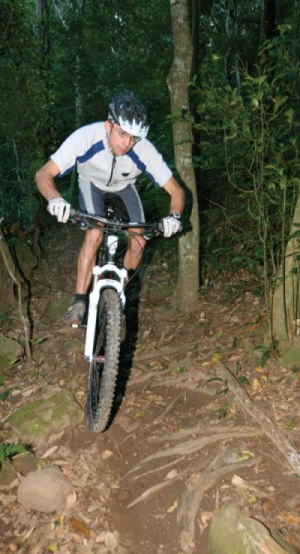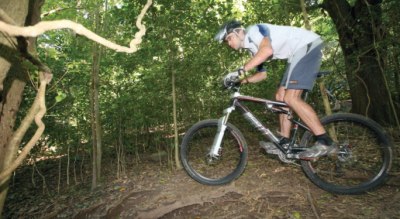How to Ride Slippery Tree Roots
Mud may be slippery and loose gravel will get your tyres in a drift but few trail surfaces compare with the unpredictability of exposed tree roots. Worn smooth by the passage of tyres, it only takes the tiniest amount of moisture to make them treacherously slippery. While the lack of traction is hard to handle, the toughest part is the variation in trail surfaces—from often loamy soil under the tree canopy with good traction to zero traction on the roots. This unpredictability means that there are no ‘step-by-step’ instructions to staying upright. Instead, you need to refine aspects of your riding technique, body position and line selection so you can handle whatever the trail throws your way. How you react will vary in every instance—a lone diagonal tree root requires a different approach to a mat of interlaced roots. Both can be your undoing, so the appropriate response needs to become a basic instinct requiring minimal thought. Getting familiar with different aspects of a good root-riding technique will equip you with the basics required to survive, gain confidence and improve…
Body Position
 The golden rule when you encounter slippery tree roots is ‘stay light on your bike’—chant it like a mantra as you approach. You need to be loose and relaxed so that your bike can move around underneath you. Keep your pedals level and hover just above the seat with your knees and elbows bent. This position aims to keep your centre of gravity low while allowing your arms and legs to function as suspension. It isolates your body from the bike and lets the wheels follow the terrain without losing forward momentum. Tensing up and forming a ‘death-grip’ on the bars will work against you—you’ll wind up fighting the bike and bouncing around rather than ‘flowing’ over the trail. While you should remain ‘light’ on the bike, your weight needs to be evenly distributed between the front and back wheels. This gives you the best chance of maintaining control when things begin to slip and slide—as they inevitably will when you hit some slippery roots!
The golden rule when you encounter slippery tree roots is ‘stay light on your bike’—chant it like a mantra as you approach. You need to be loose and relaxed so that your bike can move around underneath you. Keep your pedals level and hover just above the seat with your knees and elbows bent. This position aims to keep your centre of gravity low while allowing your arms and legs to function as suspension. It isolates your body from the bike and lets the wheels follow the terrain without losing forward momentum. Tensing up and forming a ‘death-grip’ on the bars will work against you—you’ll wind up fighting the bike and bouncing around rather than ‘flowing’ over the trail. While you should remain ‘light’ on the bike, your weight needs to be evenly distributed between the front and back wheels. This gives you the best chance of maintaining control when things begin to slip and slide—as they inevitably will when you hit some slippery roots!
Maintaining Control
Assuming a suitably relaxed position on the bike is part of the equation, how you pilot the bike is equally important. Avoid aggressive braking or sharp directional changes whilst negotiating a tree root infested section of trail. If you have to turn, do so where there is reliable traction—like on the loamy ground between the roots. Forceful pedalling should also be avoided— use light and smooth pedal strokes if you need to maintain momentum and keep your bum off the saddle while you pedal. Ideally, you should have a moderate amount of momentum before you hit the tree roots and be able to coast through in the relaxed poise that we described before. How much is a ‘moderate amount of momentum?’ Something along the lines of a brisk jog is a good starting point. If you have too much speed, do all of your braking before you hit the roots.
Line Selection
As with any type of terrain, looking ahead is a real key. Don’t worry about what’s directly under your front wheel as it’s already too late to avoid. Look some distance ahead and choose your line well in advance—this will help you remain smooth and avoid last second directional changes that will send you sliding across the roots. If an object is major enough to be a concern, you will see it from some distance. Your line choice needs to take into account the direction and frequency of the roots, the camber of the trail and of course, whether the tree roots are wet. Wet tree roots are diabolical!
One at a Time
If a lone exposed tree root can be avoided with the right line choice, then go around it—especially if the conditions are damp. When the root can’t be avoided, it should be tackled at a 90 degree angle to minimise the chances of sliding out. If a 90 degree angle of attack is not feasible without running into the bushes, a more advanced technique needs to be employed. Clearing a slippery diagonal root requires a more advanced technique that is generally known as a ‘wheelie hop’. To begin with, you need to ignore my previous advice about keeping your weight centred as a little ‘body-english’ is required. You need to pull up on the bars whilst shifting your weight back to lift the front wheel over the root. Timing is critical when attempting this—lift too early and you’ll land on the root and crash. If momentum is not on your side, a pedal stroke may be employed to assist the lifting action. Even if you can’t get the front wheel to completely clear the obstacle, this technique should unweight your front wheel enough to stop it from getting caught and sliding sideways. Naturally this is a two step approach as you have two wheels to worry about... Once your front wheel is clear, shift your weight forward and pull up on your pedals (clipless pedals help a lot here). If this doesn’t hop your rear wheel clear of the root, it will still help the tyre roll over the obstacle. If the lone tree root slopes noticeably to one side, you need to be very sure of your technique. Some cross-slope combined with the slippery wood will cause your tyre to slip sideways and you’ll be on the ground before you know it. In this situation it really pays to have your wheelie-hop down pat.
Tree Root Tangles
It is no use trying to employ the ‘wheelie hop’ technique when you have a mass of smaller interlaced tree roots that run in all different directions. Once again avoid the roots through line selection if you can. When it can’t be avoided you need to survey the camber of the trail—that is, look to see if there is any side-slope on the trail that will make you slide one way or the other.

If the trail is more or less flat, take the most direct line to where you wish to go and employ all of the ‘light and relaxed’ techniques as previously described. The bike will slip, slide and dance around between your legs, but with the right amount of momentum, you should make it across the mat of roots unscathed. Remember that you need to commit with no sharp braking or directional changes midway through. The process gets a little more complex when the trail has some cross-slope. When hitting an off-camber section of tree roots, you will automatically slide down the slope. Look to see where the camber of the trail is going to take you. It may be best to shoot for the lowest point if there is a lip that you can ride on where you can’t fall any further.
Where the conditions are super slippery, you may feel more confident if you unclip your inside foot and ‘tripod’ along the off camber slope. Only aim for the high side of a rooty off-camber trail if there is a clear and root free line—hit one slippery sucker on the highline and you’ll have an out of control joyride down to the lowest point! Processing all of these factors in fractions of a second as you approach a root infested tangle is a tall order. Still, the brain is capable of some pretty amazing feats once it has been trained to react in the correct manner. As a toddler, walking was a huge undertaking requiring great thought, commitment and a few tumbles. If slippery tree roots throw you, put some thought into your body position, stay loose and think about the line options. With practice, it too will become second nature.




